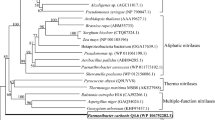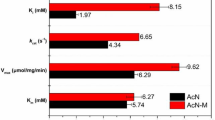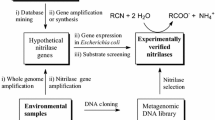Abstract
Objective
To investigate the biodegradation of nitriles via the nitrilase-mediated pathway.
Results
A novel nitrilase, BGC4, was identified from proteobacteria Paraburkholderia graminis CD41M and its potential for use in biodegradation of toxic nitriles in industrial effluents was studied. BGC4 was overexpressed in Escherichia coli BL21 (DE3), the recombinant protein was purified and its enzymatic properties analysed. Maximum activity of BGC4 nitrilase was at 30 °C and pH 7.6. BGC4 has a broad substrate activity towards aliphatic, heterocyclic, and aromatic nitriles, as well as arylacetonitriles. Iminodiacetonitrile, an aliphatic nitrile, was the optimal substrate but comparable activities were also observed with phenylacetonitrile and indole-3-acetonitrile. BGC4-expressing cells degraded industrial nitriles, such as acrylonitrile, adiponitrile, benzonitrile, mandelonitrile, and 3-cyanopyridine, showing good tolerance and conversion rates.
Conclusion
BGC4 nitrilase has wide-spectrum substrate specificity and is suitable for efficient biodegradation of toxic nitriles.
Similar content being viewed by others
Explore related subjects
Discover the latest articles, news and stories from top researchers in related subjects.Avoid common mistakes on your manuscript.
Introduction
Nitriles are widely used as starting materials and intermediates in the chemical and pharmaceutical industries and are also obtained as products, by-products, or waste products (Gong et al. 2012). Most nitriles are highly toxic, carcinogenic and mutagenic. Their release into the environment is a serious threat to living organisms (Martinkova et al. 2009). Therefore, it is essential to monitor and control their release into the environment. Compared to chemical treatment methods, biodegradation methods are generally considered more acceptable owing to their environmentally friendly nature (Banerjee et al. 2002). Nitrile-metabolizing enzymes, such as nitrile hydratase, amidase, and nitrilase, can efficiently degrade most of the toxic nitriles and thereby prevent their entry into the food chain.
Wyatt and Knowles (1995) reported the use of a mixed bacterial culture producing nitrile hydratase, amidase and nitrilases as an alternative method for treatment of industrial wastes containing various toxic nitriles such as acrylonitrile, fumaronitrile, and succinonitrile. Zhou et al. (2008) isolated two bacterial strains from acrylic fibre production effluents and used them for succinonitrile degradation.
Nitrilases convert nitriles to their corresponding carboxylic acids which are useful in the production of many important pharmaceutical intermediates and fine chemicals (Polaina and MacCabe 2007). Thus, nitrilases are known for their excellent catalytic efficiency for hydrolysis of nitriles and their environmentally benign characteristics. Based on the substrate specificities, nitrilases are generally classified into three types: aliphatic nitrilases, aromatic nitrilases, and arylacetonitrilases (Martinkova et al. 2017). Generally, a mixed culture of microorganisms producing different nitrilases should be combined for efficient degradation of industrial waste containing various nitriles and their compatibility should be considered subsequently. Therefore, identifying nitrilases with wide-spectrum substrate specificity is an attractive approach for nitrile biodegradation.
In this work, a novel nitrilase, BGC4, with wide-spectrum substrate specificity was discovered from Paraburkholderia graminis CD41M. BGC4 was cloned and overexpressed in Escherichia coli BL21 (DE3), and its biochemical properties were investigated in detail. The substrate scope of the BGC4 was tested and the nitriles degradation efficiency of the BGC4 was also investigated.
Materials and methods
Materials
Paraburkholderia graminis CD41M (ATCC 700544) was used. E. coli BL21 (DE3)/pQE-30 (Qiagen, Germany) was used for expressing recombinant nitrilase BGC4. All the nitriles and acids were purchased from Sigma-Aldrich Co. LLC. (USA) or Tokyo Chemical Industry Co., Ltd. (Japan) and were of analytical grade.
Cloning and expression of BGC4 in E. coli
The primers used for amplification of the BGC4 gene were: forward: 5′-CGGGATCCATGAAAGTTGTCAAAGCCG-3′ (BamHI) and reverse: 5′-CCCAAGCTTTCAGCGCGAACCTGCAACAG-3′ (HindIIII). BGC4-expressing strain, E. coli/BGC4, was then constructed according to standard protocols. The E. coli/BGC4 cells were cultivated at 37 °C in lysogeny broth with antibiotics. IPTG was used to induce expression. After induction, the temperature was decreased to 20 °C for further cultivation for another 20 h.
Sequence and phylogenetic analysis of the BGC4 gene
The BGC4 gene was cloned into the expression vector pQE-30 and its sequence was confirmed (BGI, Shenzhen, China) using a BLASTN search. The phylogenetic analysis of BGC4 with known nitrilases from other organisms was performed in MEGA ver. 7.0 software by the neighbour-joining method.
Purification of recombinant BGC4
The induced cells were harvested by centrifugation (8000×g, 10 min), washed twice and resuspended with Na2HPO4/NaH2PO4 buffer (50 mM, pH 7.0) and homogenized by sonication. The cell lysate was centrifuged (8000×g, 20 min) and the supernatant was loaded onto Ni–NTA resin. The nitrilase BGC4 was purified from the supernatant by Ni–NTA chromatography with imidazole gradient elution. The eluted BGC4 was desalted by dialysis and concentrated by ultrafiltration. All the purification procedures were carried out at 4 °C.
Determination of substrate specificity for BGC4
The specific activity of the nitrilase BGC4 was studied under standard conditions with different nitriles as substrates, such as aromatic nitrile, arylacetonitrile, aliphatic mono- or di-nitrile and heterocyclic nitrile. The conversion was determined by assaying the amount of ammonia produced in the reaction by the Berthelot method (Weatherburn 1967). All the experiments were carried out in triplicates.
Effect of temperature and pH on the activity of purified BGC4
Reactions were performed with 25 mM benzonitrile and 10 μg purified BGC4 for 10 min in 1 ml. The optimal temperature for BGC4 was determined from 20 to 50 °C in sodium phosphate buffer (pH 7, 100 mM). The optimal pH of BGC4 was determined from pH 4 to 9 at 25 °C using sodium citrate/citric acid buffer (pH 4–6, 100 mM), sodium phosphate buffer (pH 5.6–8, 100 mM), and Tris/HCl buffer (8–9, 100 mM).
To determine the thermostability of the nitrilase BGC4, the purified nitrilase was incubated 25, 30, 37, and 50 °C. The residual activity towards benzonitrile was measured at intervals. The stability of the purified nitrilase at pH 7, 7.6 and 8) was also measured in 100 mM sodium phosphate buffer.
Nitrile degradation assay
The induced E. coli/BGC4 cells were harvested by centrifugation and the obtained wet cells were used for nitrile degradation assay. The degradation was performed in 20 ml reaction mixture containing sodium phosphate buffer (100 mM, pH 7.6), 10% (v/v) ethanol and 2 g wet cells at 30 °C in a shaking water bath at 200 rpm. Substrate (acrylonitrile, adiponitrile, benzonitrile, mandelonitrile or 3-cyanopyridine) was added into this mixture for initiation of hydrolysis. Samples were taken at various intervals and centrifugated to remove the wet cells. The supernatant was used for the residual substrate analysis by high performance liquid chromatography (HPLC).
Analytical methods
Nitriles were quantified by HPLC using a Zorbax XDB-C18 column (4.6 mm × 250 mm, 5 μm; Agilent Technologies, Ltd., USA) at 1 ml/min. For acrylonitrile and 3-cyanopyridine the eluting solvent system was phosphoric acid (0.1%, v/v) and acetonitrile (75/25, v/v). For adiponitrile, benzonitrile and mandelonitrile the eluting solvent systems were phosphoric acid (0.1%, v/v) and methanol (90/10, v/v), (60/40, v/v) and (80/20, v/v), respectively. The eluate was monitored at 210 nm.
Results and discussion
Phylogenetic analysis of BGC4 reveals it is an aliphatic nitrilase
For identification of the novel nitrilase BGC4 (GenBank accession number: WP_006050412), phylogenetic analysis of BGC4 was performed using sequences of 19 other nitrilases that have been reported earlier. The selected nitrilases were from bacteria, fungi, and plants and have different substrate specificity. The nitrilases were grouped into three clusters in the phylogenetic tree (Fig. 1). All the nitrilases in cluster I are typical arylacetonitrilases, that use arylacetonitriles as optimal substrates. Most of the nitrilases in cluster II are from bacteria and have been reported as aliphatic nitrilases, except the two fungal nitrilases (from Fusarium oxysporum and Fusarium proliferatum). Most of the nitrilases in cluster III are eukaryotic nitrilases (from fungi and plants). The position of BGC4 in cluster II of the phylogenetic tree revealed that BGC4 may be an aliphatic nitrilase that also has some similarity with eukaryotic nitrilases.
Expression and purification of BGC4
The recombinant nitrilase BGC4 was overexpressed in E. coli in soluble form and purified by Ni–NTA chromatography. The purified BGC4 protein gave a single band at ~37 kDa in SDS-PAGE analysis (Fig. 2), which was in agreement with its predicted size. This purified BGC4 protein was then used to analyse its specific activity against various nitriles and to determine the optimal pH and temperature at which it shows maximum degradation against nitriles, specifically benzonitrile.
BGC4 exhibits wide-spectrum substrate specificity for nitriles
The specific activity of the recombinant BGC4 towards a total of 29 nitriles (aliphatic, heterocyclic, aromatic, and arylacetonitriles) is presented in Table 1. BGC4 showed a broad hydrolytic activity towards all the tested nitriles. Furthermore, its activity towards all the examined nitriles was almost of identical grade with no obvious substrate preference. Although BGC4 showed the highest activity towards iminodiacetonitrile, an aliphatic di-nitrile, comparable high hydrolytic activities were also observed on phenylacetonitrile (aromatic nitrile) and indole-3-acetonitrile (heterocyclic nitrile).
Generally, nitrilases are classified as aliphatic nitrilases, aromatic nitrilases and arylacetonitrilases according to their substrate specificities. As expected from the classification, aromatic nitrilases degrade aromatic nitriles and exhibit no or very low relative activity for aliphatic nitriles and vice versa. However, the nitrilase BGC4, which is indicated as an aliphatic nitrilase in our phylogenetic analysis, also shows high activity towards aromatic and arylacetonitriles in addition to aliphatic nitriles. Therefore, the BGC4 is a nitrilase with wide-spectrum substrate specificity and the revealed property could be a potential advantage for nitriles bioremediation and biodegradation.
Effects of temperature and pH on BGC4 activity
Purified BGC4 had maximum activity at 30 °C (Fig. 3a), and at pH 7.6 (Fig. 3b). More than 70% of maximal activity was retained between 20 and 45 °C and above 50 °C, 60% of the maximal activity was retained. Over 80% of maximal activity was maintained between pH 7 and 8.
Effects of temperature and pH on nitrilase activity and stability. a Optimal temperature. b Optimal pH; Squares sodium citrate/citric acid buffer, circles sodium phosphate buffer, triangles Tris/HCl buffer. c Thermal stability of BGC4; Circles 25 °C, squares 30 °C, triangles 37 °C, diamonds 50 °C. d pH stability of BGC4; Circles pH 7.0, squares pH 7.6, triangles pH 7.0
BGC4 at 25 and 30 °C retained activities of 73 and 68% after 48 h incubation, respectively. Additionally, the half-life of the activity at 50 °C is less than 2 h (Fig. 3c). There was little loss of activity when the enzyme was held at pH 7–8 over 48 h (Fig. 3d).
Bioremediation of nitriles by BGC4-expressing bacterial cells
To explore the potential application of BGC4 in the biodegradation of various nitriles, wet cells of E. coli/BGC4 were used as biocatalyst for the degradation of acrylonitrile, adiponitrile, benzonitrile, mandelonitrile, and 3-cyanopyridine at high substrate concentrations (Fig. 4). The two typical aliphatic nitriles, acrylonitrile and adiponitrile, are widely used in the synthesis of fibre, rubber, and resin industries and thus widespread in industrial effluents. On the other hand, the nitriles benzonitrile and mandelonitrile, representative of aromatic nitriles and arylacetonitriles respectively, are important materials in organic synthesis and pharmaceuticals industries (Martinkova et al. 2009; Suwanvaipattana et al. 2017). For the degradation of both adiponitrile and mandelonitrile, 200 mM the substrate could be completely hydrolysed in less than 1.5 h. Moreover, 200 mM benzonitrile and 100 mM 3-cyanopyridine were also completely hydrolysed in less than 3 h. Although BGC4 revealed a relatively low activity towards acrylonitrile, 50 mM acrylonitrile was completely hydrolysed in less than 3 h.
Many nitrilases-mediated nitriles hydrolysis have been reported. Among them, seven of these reported nitrilases with noteworthy catalytic performance towards acrylonitrile, mandelonitrile or 3-cyanopyridine are compared in Table 2. Only the nitrilase from Rhodococcus ruber AKSH-84 could hydrolyze acrylonitrile efficiently in a high substrate concentration. When 200 mM acrylonitrile was used, the conversion rate reached 63% with wet cells (200 mg/ml) in 120 min. In the current study, 100% conversion rate was achieved in 180 min with less biocatalysts (100 mg/ml) with substrates at 50 mM. In addition, the nitrilase BCJ2315 from Burkholderia cenocepacia J2315 has shown the highest activity towards mandelonitrile to date. Compared to the nitrilase BCJ2315, BGC4 also showed high catalytic efficiency towards mandelonitrile and could hydrolyze 200 mM mandelonitrile completely in 90 min. For the 3-cyanopyridine hydrolysis, although the top rank of the biocatalysts were Rhodococcus sp. NDB 1165 and Nocardia globerula NHB-2, BGC4 showed a 100% conversion rate on a comparable high substrate concentration (100 mM). Therefore, BGC4 demonstrated great potential for the application of various nitriles degradation.
In the last decade, several studies on nitriles degradation through nitrilase-mediated pathway have been reported (Fang et al. 2015; Liu et al. 2017; Mukram et al. 2016). However, most of these studies report nitrilases that are effective in degrading a few substrates. In the present study, we report a promising nitrilase BGC4 that can degrade a wide range of nitriles and thus has considerable application potential.
Conclusion
A novel nitrilase, BGC4, with wide-spectrum substrate specificity has been identified from Paraburkholderia graminis. The use of BGC4 nitrilase is not only environmentally friendly but also highly effective in degrading a wide range of nitriles. These outstanding characteristics of BGC4 make it a potential candidate for efficient degradation of toxic nitriles in effluents.
References
Ahmed K, Kumar MS, Kumar CG, Shaik TB (2011) Bioconversion of acrylonitrile to acrylic acid by Rhodococcus ruber strain AKSH-84. J Microbiol Biotechnol 21:37–42
Banerjee A, Sharma R, Banerjee UC (2002) The nitrile-degrading enzymes: current status and future prospects. Appl Microbiol Biotechnol 60:33–44
Fang S, An X, Liu H, Cheng Y, Hou N, Feng L, Huang X, Li C (2015) Enzymatic degradation of aliphatic nitriles by Rhodococcus rhodochrous BX2, a versatile nitrile-degrading bacterium. Bioresour Technol 185:28–34
Gong JS, Lu ZM, Li H, Shi JS, Zhou ZM, Xu ZH (2012) Nitrilases in nitrile biocatalysis: recent progress and forthcoming research. Microb Cell Fact 11:142
Liu C, Yuan K, Chen RP, Chen MJ, Yu L (2017) Biodegradation kinetics of nitriles with easily degradable substrate by Klebsiella oxytoca GS-4-08. Int Biodeterior Biodegrad 118:95–101
Martinkova L, Uhnakova B, Patek M, Nesvera J, Kren V (2009) Biodegradation potential of the genus Rhodococcus. Environ Int 35:162–177
Martinkova L, Rucka L, Nesvera J, Patek M (2017) Recent advances and challenges in the heterologous production of microbial nitrilases for biocatalytic applications. World J Microbiol Biotechnol 33:8
Mukram I, Ramesh M, Monisha TR, Nayak AS, Karegoudar TB (2016) Biodegradation of butyronitrile and demonstration of its mineralization by Rhodococcus sp. MTB5. 3 Biotech 6:141
Nageshwar YVD, Sheelu G, Shambhu RR, Muluka H, Mehdi N, Malik MS, Kamal A (2011) Optimization of nitrilase production from Alcaligenes faecalis MTCC 10757 (IICT-A3): effect of inducers on substrate specificity. Bioproc Biosyst Eng 34:515–523
Polaina J, MacCabe AP (2007) Industrial enzymes. Springer, Berlin, pp 531–547
Prasad S, Misra A, Jangir VP, Awasthi A, Raj J, Bhalla TC (2007) A propionitrile-induced nitrilase of Rhodococcus sp. NDB 1165 and its application in nicotinic acid synthesis. World J Microbiol Biotechnol 23:345–353
Sharma NN, Sharma M, Bhalla TC (2011) An improved nitrilase-mediated bioprocess for synthesis of nicotinic acid from 3-cyanopyridine with hyperinduced Nocardia globerula NHB-2. J Ind Microbiol Biotechnol 38:1235–1243
Suwanvaipattana P, Limtrakul S, Vatanatham T, Ramachandran PA (2017) Modeling of electro-organic synthesis to facilitate cleaner chemical manufacturing: adiponitrile production. J Clean Prod 142:1296–1308
Wang H, Sun H, Wei D (2013) Discovery and characterization of a highly efficient enantioselective mandelonitrile hydrolase from Burkholderia cenocepacia J2315 by phylogeny-based enzymatic substrate specificity prediction. BMC Biotechnol 13:14
Weatherburn MW (1967) Phenol-hypochlorite reaction for determination of ammonia. Anal Chem 39:971–974
Wyatt JM, Knowles CJ (1995) The development of a novel strategy for the microbial treatment of acrylonitrile effluents. Biodegradation 6:93–107
Zhou XF, Zhang YL, Xu DQ, Cao WH, Dai CM, Qiang ZM, Yang Z, Zhao JF (2008) Treatment of succinonitrile wastewater by immobilized high efficiency microorganism strains. Water Sci Technol 58:911–918
Acknowledgments
This work was supported by the National Natural Science Foundation of China (Grant No. 21406068/B060804), the Fundamental Research Funds for the Central Universities.
Author information
Authors and Affiliations
Corresponding author
Rights and permissions
About this article
Cite this article
Fan, H., Chen, L., Sun, H. et al. Characterization of a novel nitrilase, BGC4, from Paraburkholderia graminis showing wide-spectrum substrate specificity, a potential versatile biocatalyst for the degradation of nitriles. Biotechnol Lett 39, 1725–1731 (2017). https://doi.org/10.1007/s10529-017-2410-6
Received:
Accepted:
Published:
Issue Date:
DOI: https://doi.org/10.1007/s10529-017-2410-6








